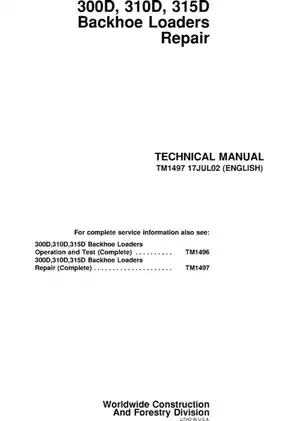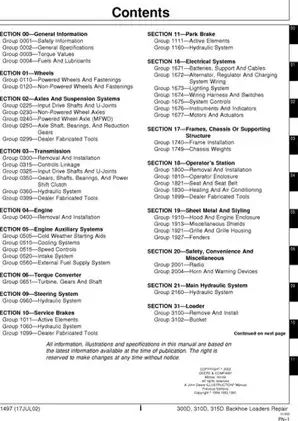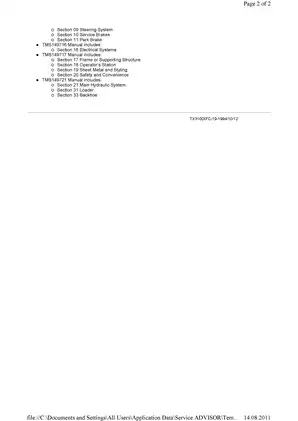John Deere 300D, 310D, 315D Backhoe Loader Repair Manual - Factory Service & Repair Reference
Product Gallery

Sample pages from the John Deere 300D, 310D, 315D Backhoe Loader Repair Manual - Factory Service & Repair Reference manual



Purchase Information
John Deere 300D, 310D, 315D Backhoe Loaders Technical Manual - Technical Specifications
- Document Number / Seller:
- 29588 / Paul Collins
- File Size:
- 212.22 MB
- File Type:
- Language:
- English
- Pages:
- 1393
- Printable:
- Yes
- Estimated Download Time:
- 4.35 Minutes
- Delivery Format:
- Digital (PDF) - Instant Access
- Category:
- Backhoe Loader
- Brand:
- John Deere
- Reviewed and Approved:
- Sep 8, 2025
John Deere Models and Parts Covered in this Backhoe Loader Manual
- John Deere 300D
- John Deere 310D
- John Deere 315D
Complete Manual Information
Comprehensive Repair/Technical Manual for John Deere 300D, 310D, 315D Backhoe Loaders
This detailed technical manual (TM1497 17JULO2) is your essential guide for servicing and maintaining John Deere's popular 300D, 310D, and 315D Backhoe Loaders. Designed specifically for experienced technicians, it offers a wealth of information crucial for effective repairs and operations.
Features
- Safety Information: Prioritize your safety with thorough guidelines for working with hazardous materials and high-pressure systems.
- Step-by-Step Instructions: Each section is meticulously organized to help you quickly find specific tasks ranging from engine repairs to hydraulic system maintenance.
- Maintenance Protocols: Learn about essential maintenance practices to ensure your backhoe loaders operate efficiently and safely.
What's Inside?
This manual covers a wide array of topics organized into the following sections:
- Section 00 - General Information
- Safety Information, General Specifications, Torque Values, and Fuel & Lubricants
- Section 01 - Wheels
- Details about Powered and Non-Powered Wheel Assemblies
- Section 02 - Axles and Suspension Systems
- Comprehensive information on drive shafts and axles
- Section 03 - Transmission
- Removal, installation, and maintenance details
- Section 04 - Engine
- In-depth instructions for engine removal and installation
- Section 16 - Electrical Systems
- Coverage of batteries, wiring, and instrumentation
- Additional Sections covering operator's station, brakes, frames, and hydraulic systems.
With this manual, you will not only understand how to repair and maintain the John Deere 300D, 310D, and 315D but also improve the longevity and reliability of these essential machines
Download Instructions for John Deere Backhoe Loader Manual
Frequently Asked Questions - John Deere Backhoe Loader Manual
What does this John Deere manual cover?
This comprehensive service manual covers detailed repair procedures, maintenance schedules, troubleshooting guides, and technical specifications for John Deere 300D, 310D, 315D Backhoe Loader Repair Manual - Factory Service & Repair Reference. It includes information for the following models: - John Deere 300D - John Deere 310D - John Deere 315D.
Is this manual suitable for beginners?
Yes, this John Deere manual is designed for both professional technicians and DIY enthusiasts. It includes step-by-step procedures with clear illustrations and safety guidelines for Backhoe Loader maintenance and repair.
What file format will I receive?
You will receive this manual as a PDF file (212.22 MB), which is compatible with all devices. The manual is fully searchable and printable for your convenience.
How quickly can I access the manual after purchase?
You'll receive instant access to your John Deere Backhoe Loader manual immediately after payment completion. The download link is valid for 3 days, with lifetime re-download guarantee.
Can I print specific sections of the manual?
Absolutely! This digital manual allows you to print any section you need, from individual pages to complete chapters, making it perfect for workshop use.
Customer Reviews and Feedback
Read what our customers say about this John Deere Backhoe Loader manual and share your own experience.
Add Comment
This policy contains information about your privacy. By posting, you are declaring that you understand this policy:
- Your name, rating, website address, town, country, state and comment will be publicly displayed if entered.
- Aside from the data entered into these form fields, other stored data about your comment will include:
- Your IP address (not displayed)
- The time/date of your submission (displayed)
- Your email address will not be shared. It is collected for only two reasons:
- Administrative purposes, should a need to contact you arise.
- To inform you of new comments, should you subscribe to receive notifications.
- A cookie may be set on your computer. This is used to remember your inputs. It will expire by itself.
This policy is subject to change at any time and without notice.
These terms and conditions contain rules about posting comments. By submitting a comment, you are declaring that you agree with these rules:
- Although the administrator will attempt to moderate comments, it is impossible for every comment to have been moderated at any given time.
- You acknowledge that all comments express the views and opinions of the original author and not those of the administrator.
- You agree not to post any material which is knowingly false, obscene, hateful, threatening, harassing or invasive of a person's privacy.
- The administrator has the right to edit, move or remove any comment for any reason and without notice.
Failure to comply with these rules may result in being banned from submitting further comments.
These terms and conditions are subject to change at any time and without notice.
Comments (6)